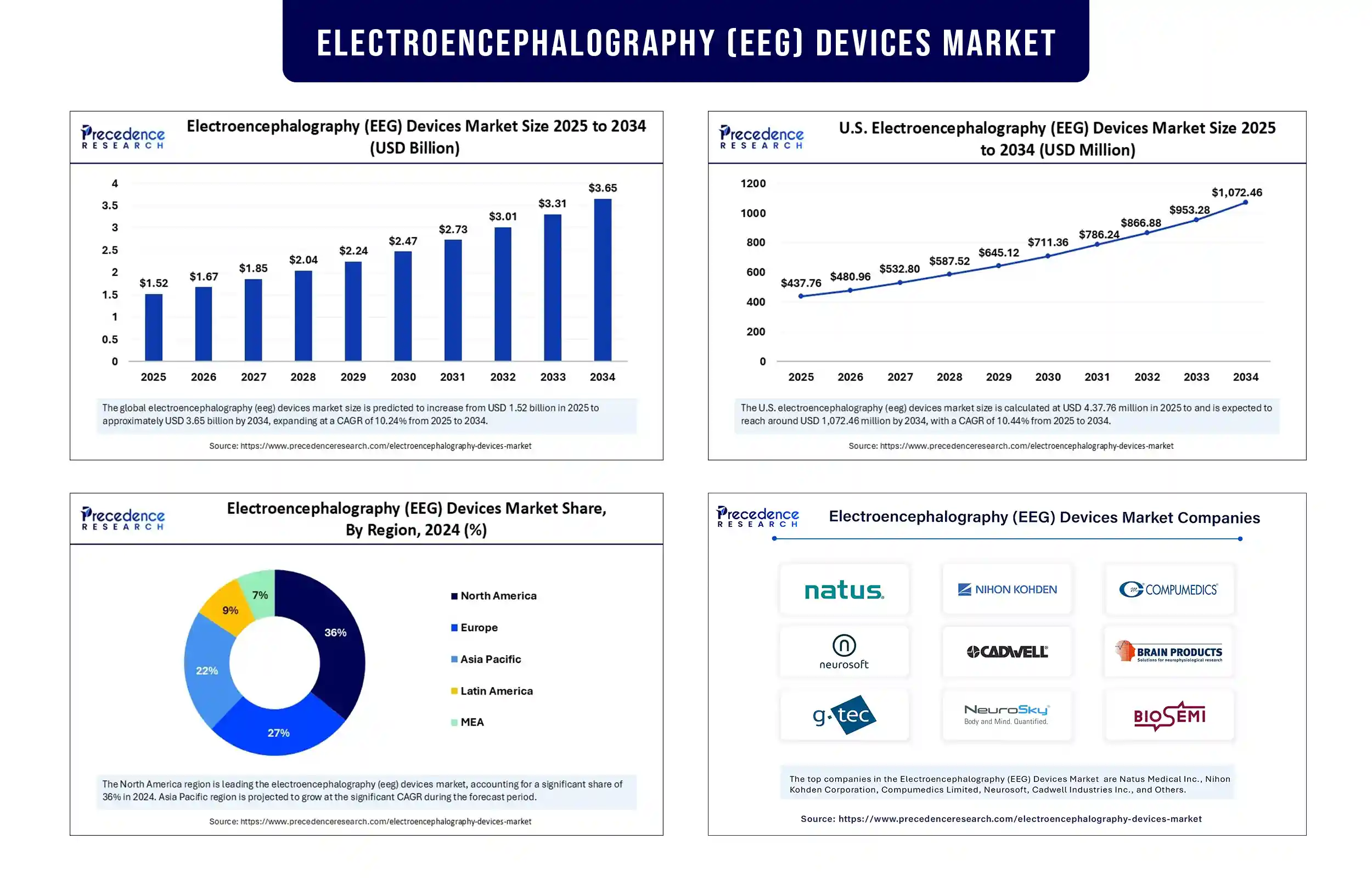Electroencephalography (EEG) Devices Market Revenue to Attain USD 3.3 Bn by 2033
Electroencephalography (EEG) Devices Market Revenue and Trends 2025 to 2033
The electroencephalography (EEG) devices market revenue is estimated at USD 1.52 billion in 2025 and is predicted to attain around USD 3.31 billion by 2033, growing at a CAGR of 10.24% during the forecast period from 2025 to 2034. This market is blooming due to the increasing global prevalence of neurological disorders and the growing demand for non-invasive monitoring technologies. Moreover, ongoing technological advancements open up new growth avenues for the market.

Exploring the Growth Potential of the Market:
Several factors are responsible for the growth of the electroencephalography (EEG) devices market. One of the major factors is the increasing number of individuals diagnosed with neurological disorders, such as epilepsy, Alzheimer’s disease, Parkinson’s disease, and sleep disorders. EEG devices are required to manage these conditions as they provide a non-invasive way to measure the brain's electrical activity. There is an increased emphasis on early diagnosis of neurological disorders due to the heightened awareness among people about the importance of brain health, prompting the urgent need for EEG devices.
Innovation in EEG devices creates immense opportunities in the market. Technological advances have led to the development of wireless EEG systems and portable devices, making it easier to remotely monitor conditions and enable point-of-care diagnostics. In addition, integrating artificial intelligence (AI) and machine learning (ML) algorithms into these devices leads to more accurate diagnostics, enabling early intervention and enhancing patient outcomes.
Segment Insights:
- By product type, the standalone EEG devices segment is leading the market, owing to their portability and ease of use. They are suitable for various settings, ranging from clinics and hospitals to research labs. The increased need for point-of-care diagnostics bolsters segmental growth.
- By modality, the standard EEG segment held the largest share of the market in 2024 due to its high precision, low cost, and widespread application in hospitals and neurological diagnostic centers.
- By application, the disease diagnosis segment led the market with a major revenue share in 2024. This is mainly due to the increased prevalence of neurological disorders and heightened demand for precise detection as well as early detection. The rising investments in advanced diagnostic solutions further support segmental growth.
- By end-user, the hospitals segment contributed the largest market share in 2024. This is mainly due to the increased hospital admission rates. Hospitals often have dedicated teams for neurological disorders and advanced diagnostic solutions, encouraging patients to receive care from these settings. The rising government investments to modernize existing public hospitals further support segmental growth.
- By channel type, the 21-channel EEG segment is the leading segment, as it provides detailed information on brain activity, resulting in early diagnosis.
- By portability type, the fixed EEG systems segment dominated the market in 2024. The adoption of fixed EEG systems has increased due to their high accuracy in interpreting brain signals and their widespread application in hospitals and research organizations.
Regional Insights:
North America dominated the global electroencephalography (EEG) devices market, capturing the largest share in 2024. This is due to a well-established healthcare system and the presence of a large number of medical device companies. There is a heightened awareness of neurological disorders, encouraging people to undergo diagnostics. This boosts the demand for EEG devices.
Asia Pacific is expected to grow at the fastest rate during the forecast period. Rising government investments in modernizing healthcare systems and increasing awareness of brain health are major factors driving the market's growth. With the increasing prevalence of brain disorders, there has been a significant demand for advanced diagnostic devices to facilitate early diagnosis, driving market growth.
Electroencephalography (EEG) Devices Market Coverage
| Report Attribute | Key Statistics |
| Market Revenue in 2025 | USD 1.52 Billion |
| Market Revenue by 2033 | USD 3.31 Billion |
| CAGR from 2025 to 2033 | 10.24% |
| Quantitative Units | Revenue in USD million/billion, Volume in units |
| Largest Market | North America |
| Base Year | 2024 |
| Regions Covered | North America, Europe, Asia-Pacific, Latin America, and Middle East & Africa |
Recent Development:
In May 2025, Japan-based Epsilon Medical Inc. announced that the FDA has granted Breakthrough Device designation for the company’s EP-01 endovascular EEG device. The EP-01 device is intended for temporary use in recording and monitoring brain electrical signals in patients with drug-resistant epilepsy.
Electroencephalography (EEG) Devices Market Key Players
- Natus Medical Inc.
- Nihon Kohden Corporation
- Compumedics Limited
- Neurosoft
- Cadwell Industries Inc.
- Micromed Group
- Brain Products GmbH
- g.tec medical engineering GmbH
- Electrical Geodesics Inc. (EGI) – now part of Philips
- NeuroSky Inc.
- Bitbrain Technologies
- EMOTIV Inc.
- Biosemi B.V.
- Advanced Brain Monitoring Inc.
- Wearable Sensing
- Masimo Corporation (via acquisition of EEG monitoring capabilities)
- Mindray Medical International Limited
- Medtronic plc
- Integra LifeSciences
- Deymed Diagnostic
Get this report to explore global market size, share, CAGR, and trends, featuring detailed segmental analysis and an insightful competitive landscape overview @ https://www.precedenceresearch.com/sample/6323
You can place an order or ask any questions, please feel free to contact at sales@precedenceresearch.com |+1 804 441 9344